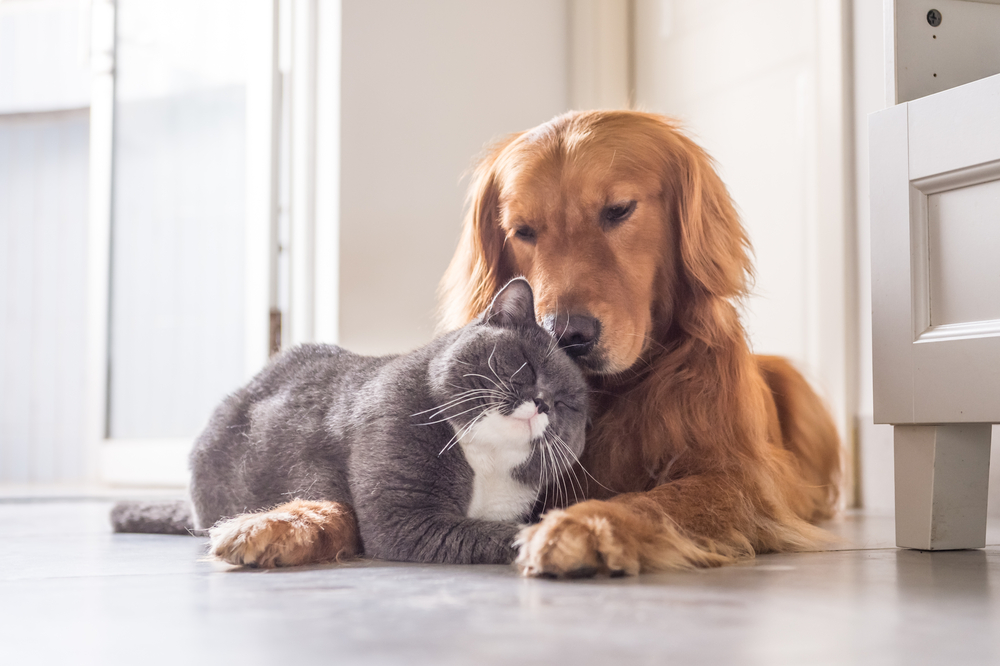We’ve all seen the viral videos of cats and dogs curled up in the most adorable cuddle puddle imaginable. It just makes your heart melt. But it also might make you wonder whether the furbabies in your own home could ever learn to live so harmoniously with each other.
Whether you’ve been struggling to get your pets to like each other or you’re thinking of introducing a new member to the furry family, don’t worry. With some patience and intentionality, you can introduce your dog and cat in a way that will improve the chances for future cuddle sessions. You’re going to want to get your camera ready with these tips on introducing furry friends-to-be!
First, let’s talk about pupper politeness
Often, the biggest hurdle to successful relationship-building between dogs and cats is that dogs are, well, a little much for cats to handle. Some dogs tend to be excited and playful, while others see cats as something fun to chase. That’s why it’s crucial to get your dog’s behaviour under control before ever stepping foot in your feline’s territory!
Here are few basic cues that Fido should be excellent at before you introduce your dog and cat:
- Sit or lay down
- Stay
- Leave it
It’s also a brilliant idea to desensitise and counter condition your dog to your cat or cats in general at a distance before moving on to the next step. This will include exposing your dog to the smell, sound and sight of cats and rewarding your dog for calm behaviour. Teaching your dog to be relaxed around small animals will be incredibly useful when you’re ready to bring your pupper snout-to-snout with their furrever friend.
If your dog is especially cat-hesitant, take a look at our article, How to Get Your Dog to Like Cats.
Ask your cat about their ideal first date
Okay, no. You can’t actually ask your cat what they would want from a first meeting with your dog. But, you can learn more about feline behaviour and use it to make the conditions just right for your introduction! Here are a few things your cat would like you to know before you put them in a room with the dog:
- They want to do a background check. Before your cat comes whiskers-to-whiskers with the dog, they’ll want to gather as much information as possible. You can help them by allowing them to sniff some of the dog’s toys, explore the area where the dog spends the most time, and watch the dog from a safe distance (such as in a windowsill while the dog is playing outside.) This will help your cat feel less surprised when they come into contact with your dog.
- They want to have the high ground. Cats are natural tree-dwellers, which means that they’ll feel much more comfortable meeting Fido from above. This could be a cat tree or non-slippery shelves or ledges where your cat feels comfortable.
- They don’t want to feel cornered. Even if your dog is the perfect gentleman or lady, your cat will want to know they have an escape route if need be. If they do decide to leave early, let them go! Just make sure that the dog doesn’t chase after them.
- They want to be in charge. You might have spent weeks training your dog to be the perfect cat companion, but at the end of the day, your cat is going to call the shots here! Make sure to take cues from your cat’s body language.
It’s important to remember that cats are the prey animal in this relationship! So you’ll want to go out of your way to learn what they need to feel comfortable.
It’s time to introduce your dog and cat!
You’ve gone over basic doggy manners with your dog and created a soothing environment for your cat. It’s time for the two to finally meet each other!
But before you do, make sure to exercise your dog so that they’re in a good, calm mood. If you can’t get your pooch out yourself, consider calling in a friendly Dog Walker to take them on a brisk walk. Or, play a rigorous game of tug or fetch in the backyard.
Then, with Fido on leash and a bag of treats in hand, introduce your dog and cat in an area that meets all of your cat’s comfort requirements. If your dog can stay calm, reward them with treats and positive praise. If your dog is overly excited, remove them until they’re calm and try again.
Your cat may not be as willing to accept treats as their future furry friend, but you should try giving them some special treatment as well. This will allow your cat to build positive associations with the dog.
If your first meeting is very short, or a series of very short sessions, that’s okay! It’s actually preferable that these early interactions last no longer than a few minutes at a time. With consistency, your dog and cat should be able to remain calm around each other for longer periods.
How long after you introduce your dog and cat can you expect them to be mates?
Every dog and cat dynamic is different, which is why it’s impossible to say how long it will take for them to warm up to each other.
In some cases, cats and dogs who have been properly introduced only need a few hours to go from strangers to BFFs. But it’s much more common for dogs and cats to need more time, up to weeks or months, before they feel comfortable in each other’s presence.
The most important thing is that you stay consistent. Short daily sessions will allow your furbabies to start seeing each other as a predictable part of their everyday lives.
What if it seems like your dog and cat are destined to distrust each other?
Maybe you’ve been trying for months to introduce your dog and cat and they don’t seem to be making any progress. Here are a few final words of advice:
- Serve meals on opposite sides of the door. Sometimes it can be helpful to build positive associations with your pets by using the thing they love most in the world: food! By feeding them on opposite sides of a door, they can begin to associate their meals with the presence of the other pet. Over time, you might be able to replace the door with a baby gate or other transparent barrier.
- Play distraction games with your dog around the cat. In the animal world, eye contact is a big no-no. And your dog might be making your cat uncomfortable by staring! You can interrupt this behaviour by distracting your dog with a training session or scent tracking game.
- Call in an animal behaviourist. Animal behaviourists are trained in pet psychology so that you can be sure that you’re using the right techniques with your dog and cat. Having a professional in the room is a fantastic way to move things along in the safest way possible.
- Always consider your pet’s safety and wellbeing. In some cases, dogs and cats are simply not destined to be best friends. If your pets are not making progress, fighting, or generally showing symptoms of stress, it might be time to admit that they’re happier in their own spaces. Don’t leave them alone together, and consider calling on the help of an experienced Pet Sitter when you can’t be there to supervise.
Are you ready to introduce your dog and cat?
With some planning, training, treats, and plenty of patience, you can introduce your dog and cat in a way that is most likely to result in a special canine-feline bond!


